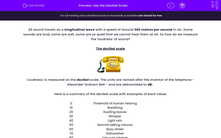All sound travels as a longitudinal wave with a speed of around 300 metres per second in air. Some sounds are loud, some are soft, some are so quiet that we cannot hear them at all. So how do we measure the 'loudness' of sound?
The decibel scale

'Loudness' is measured on the decibel scale. The units are named after the inventor of the telephone - Alexander Graham Bell - and are abbreviated to dB.
Here is a summary of the decibel scale with examples of each value:
| 0 | Threshold of human hearing |
| 10 | Breathing |
| 20 | Rustling leaves |
| 30 | Whisper |
| 40 | Light rain |
| 50 | Normal talking volume |
| 60 | Busy street |
| 70 | Dishwasher |
| 80 | Vacuum cleaner |
| 90 | Hairdryer |
| 100 | Motorbike |
| 110 | Chainsaw |
| 120 | Police siren |
| 130 | Aeroplane taking off |
The threshold of human hearing at 0 dB is the minimum possible intensity of sound that we can hear. Anything below 0 dB would be impossible for our ears to detect, so it is the logical place to start the scale.
What volumes are dangerous?
Hearing loss can be caused by the build up of earwax, infections, and older age. It can also be caused by exposure to loud sounds.
Any noise above 70 dB can start to damage your hearing if you are exposed to it for long periods. (Before you use this as an excuse to avoid using a vacuum cleaner, this would only become an issue if you used it repeatedly every day for hours!). At maximum volume, listening to music through earbuds can go above 100 dB, so you do need be aware of the volume that you listen to your music and the time you spend using such volumes.

Very loud sounds above 120 dB can cause immediate damage to your ears and can even cause hearing loss. The volume of a typical rock concert will range from 90 - 120 dB, which is why it is advisable to wear earplugs at such events.
Anyone who works with loud noises on a daily basis, for example construction workers, will need to wear ear defenders to absorb sound waves and reduce the risk of permanent hearing damage.

Now that you have seen the decibel scale, let's have a go at answering some questions to test your knowledge.







